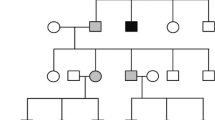Abstract
The aim of this study was to estimate the risk of viable unbalanced offspring for a parental carrier of reciprocal translocation. On a large computerized database of reciprocal translocations we used logistic regression to model this risk. The status of the progeny is the outcome variable. Explanatory covariates are cytogenetic characteristics of the translocation, age and sex of the parental carrier, and potential viability of the gametes. The results obtained by the logistic model demonstrate the important role of certain variables such as the sex of the parental carrier and the R band length of the translocated segments. Within the group of lower risk (risk of viable unbalanced offspring less than 5%), 97% of the individuals are correctly classified with this model. For this group, the choice prenatal diagnosis can be best discussed by considering both the risk for viable unbalanced offspring and the risk of induced abortion following prenatal diagnosis.
Similar content being viewed by others
References
Alberman E (1973) Epidemiology of spontaneous abortions and their chromosome constitution. In: Boué A, Thibault C (eds) Chromosomal errors in relation to reproductive failure. INSERM, Paris, pp 305–316
Boué J, Boué A, Lazar P (1975) Retrospective and prospective epidemiological studies of 1500 karyotyped spontaneous human abortions. Teratology 12:11–26
Boué A, Gallano P (1984) A collaborative study of the segregation of inherited chromosome structural rearrangements in 1356 prenatal diagnoses. Prenat Diagn 4:45–67
Cans C, Cohen O, Mermet MA, Demongeot J, Jalbert P (1993) Human reciprocal translocations: is the unbalance mode at birth predictable? Hum Genet 91:228–232
Cohen O, Cans C, Mermet MA, Demongeot J, Jalbert P (1992) Human reciprocal translocations: a new computer system for genetic counseling. Ann Génét 35:193–201
Crandall BF, Lebherz TB, Rubinstein L, Robertson RD, Sample WF, Sarti D, Howard J (1980) Chromosomes findings in 2500 second trimester amniocentesis. Am J Med Genet 5:345–356
Daniel A (1979) Structural differences in reciprocal translocations. Potential for a model of risk in reciprocal translocations. Hum Genet 51:171–182
Daniel A, Hook EB, Wulf G (1988) Collaborative USA data on prenatal diagnosis for parental carriers of chromosome rearrangements: risk of unbalanced progeny. In: Daniel A (ed) The cytogenetics of mammalian autosomal rearrangements, Liss, New York, pp 73–162
Davis JR, Rogers BB, Hagaman RM, Thies CA, Veomett IC (1985) Balanced reciprocal translocations: risk factors for aneuploid segregant viability. Clin Genet 27:1–19
De Arce MA, Grace PM, McManus S (1986) A computer model for the study of segregation in reciprocal translocation carriers: application to 20 new cases. Am J Hum Genet 24:519–525
Gardner RJM, Sutherland GS (1989) The simple reciprocal translocation. In: Motulsky AG, Bobrow M, Harper PS, Scriver C (eds) Oxford monographs on medical genetics no. 17. Chromosome abnormalities and genetic counseling. Oxfort University Press, Oxford, pp 29–46
Greenland S (1989) Modeling and variable selection in epidemiologic analysis. Am J Public Health 79:340–349
Hastie T, Tibshirani R (1990) Generalized additive models. Chapman & Hall, London
Hosmer DW, Lemeshow S (1989) Applied logistic regression. Wiley, New York
ISCN (1981) An international system for human cytogenetic nomenclature. High resolution banding. Cytogenet Cell Genet 11:88–94
Jalbert P, Jalbert H, Sele B (1988) Types of imbalances in human reciprocal translocations: risks at birth. In: Daniel A (ed) The cytogenetics of mammalian autosomal rearrangements. Liss, New York, pp 267–291
Jalbert P, Cohen O, Cans C, Mermet MA, Demongeot J (1992) Unbalances of reciprocal translocations (rcp): maximum thresholds of viability. Am J Hum Genet 51: A1240
Jennings DE (1986) Outliers and residual distributions in logistic regression. J Am Statist Assoc 81:987–990
Landwehr J, Pregibon D, Shoemaker AC (1984) Graphical methods for assessing logistic regression models. J Am Statist Assoc 79:61–71
McCullagh P, Neider JA (1989) Generalized linear models. Chapman & Hall, London
Payne CD (ed) (1987) GLIM system release 3.77 manual. Oxford, UK
Petrosky DL, Bergaonkar DS (1984) Segregation analysis in reciprocal translocation carriers. Am J Med Genet 19:137–159
Pregibon D (1981) Logistic regression diagnostics. Ann Statistics 9:705–724
Stene J (1989) Comments on estimations of risks to translocation carriers. Am J Med Genet 33:54–57
Stengel Rutkowski S, Stene J, Gallano P (1988) Risk estimates in balanced reciprocal translocations. (Monographie des annales de génétique), Expansion Scientifique Française, Paris
Author information
Authors and Affiliations
Rights and permissions
About this article
Cite this article
Cans, C., Cohen, O., Lavergne, C. et al. Logistic regression model to estimate the risk of unbalanced offspring in reciprocal translocations. Hum Genet 92, 598–604 (1993). https://doi.org/10.1007/BF00420946
Received:
Revised:
Issue Date:
DOI: https://doi.org/10.1007/BF00420946



